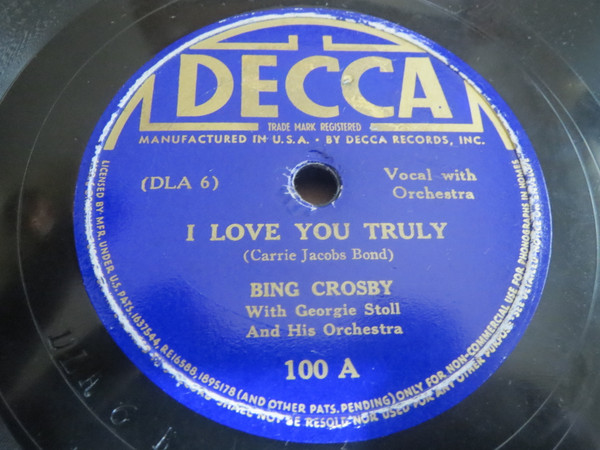In the first part of this post I examined the journey of Carrie Jacobs-Bond’s song, “I Love You Truly” during the first half of the 20th century, from its publication in 1901 into the 1940s. What began as a deeply personal response to the accidental death of her husband, Frank Bond, evolved into an iconic wedding song performed thousands upon thousands of times, year after year. When movies added sound, directors and producers continued the practices of pianists, organists, and orchestras that had accompanied silent films, playing “I Love You Truly” whenever weddings or declarations of love flashed on the screen. Adding to the song’s popularity, after fifteen years of opera singers recording the song – including Sophie Braslau, for the first time in 1917, Frances Alda (1923), Dusolina Giannini (1926) – big bands discovered it.
As “I Love You Truly” became a standard part of North American weddings, churches in the United States and Canada began to outlaw it. The first account of it being banned in churches was in one of the cities and states that had first embraced it, Des Moines, IA, in 1927. Catholic Bishop Thomas W. Drumm forbad its singing at weddings held in St. Ambrose Cathedral. When told of this decision, Jacobs-Bond replied (11 Oct. 1927), “When I was a girl, love was a sacred thing – I hope it still is. Just say that I regard the Des Moines church action as a compliment. As for ‘I Love You Truly’ being too light for church wedding services, why should these services be so solemn? Aren’t they supposed to be happy affairs?”
The Pivotal Decade
Within a few years, this localized action began to spread. In 1930 the Catholic Archbishop of San Francisco prohibited churches in his diocese from allowing performances of this and other frequently requested songs. Archbishop Edward J. Hanna’s edict named it and a few others: “Profane melodies such as [Reginald De Koven’s] “O Promise Me,” “I Love You Truly,” [Charles Wakefield Cadman’s] “At Dawning,” etc., are strictly forbidden.” He also included Wagner’s “Pilgrim’s Chorus” from Tannhäuser and the Meditation from Massenet’s Thaïs. The first Lutheran church to join this movement was St. Luke’s Evangelical church in Chicago, part of the Missouri Synod. They not only banned “I Love You Truly,” “O Promise Me” and other songs “which have no religious or churchly character,” but also the customs of throwing rice and confetti and even that of the bride and groom kissing at the altar at the end of the ceremony. The church was praised for guarding “against having its house of worship turned into a neighborhood circus” (1932). A few years later Faith Lutheran Church in Cleveland followed this ruling in every detail (1938).
Church leaders may have taken action in the 1930s not just because of how often it was programmed at weddings, but because this was the decade in which popular culture – big bands, films, radio networks, recording companies – embraced “I Love You Truly.” This song was not only Bing Crosby’s first hit with Decca Records in 1934, it was his first Decca recording altogether; indeed, Jack Kapp chose this recording to launch Decca Records. In England that year, Al Bowlly issued his
No year had more weddings that programmed “I Love You Truly” than 1946, the year soldiers returned home, many of them to long-delayed weddings. Fitting, then, that this is also the year Frank Capra’s It’s a Wonderful Life appeared. Nominated for six Academy Awards, including best sound recording, the film invokes “I Love You Truly” at its romantic climax. When George Bailey (James Stewart) finally returns home to Mary (Donna Reed), they embrace. “Remember the night we broke the window in this old house?” she asks, “This is what I wished for.” Two old men stand outside in the rain and serenade them, singing a harmonized arrangement of “I Love You Truly.”
A sure sign of the continuing popularity this song enjoyed in the 1950s: religious bans escalated. In 1951 the Canadian College of Organists petitioned the Council of Churches to forbid weddings in Protestant Canadian churches from allowing “I Love You Truly” and “I’ll Walk Beside You.” At the time, such an injunction was already in place in Catholic churches in Ontario. One vocal supporter of this policy was Sir Ernest MacMillan, director of the Toronto Symphony. The following year in New York State, an Episcopal diocesan commission on church music recommended abolishing music that only “glorifies the romantic attraction of the marriage partners without any attempt to dignify the new relation before God,” songs such as “I Love You Truly,” “O Promise Me,” and Guy d’Hardelot’s “Because” (1952). Next in this wave of opprobrium, the Catholic archdioceses of Boston and Providence, RI, disallowed “I Love You Truly” along with the wedding marches of Wagner and Mendelssohn in 1953.
The most sweeping ban came in 1955 in the Catholic Archdiocese of Chicago. In a decision that was written about and discussed across the country, Cardinal Stritch outlawed thirteen compositions: the Wagner and Mendelssohn wedding marches, eight versions of the Ave Maria (including those by Bach-Gounod, Schubert and Verdi), “I Love You Truly,” “O Promise Me,” and “Because.” Beginning with the first Sunday of Advent (27 Nov.), “no deviation can or will be permitted.” Interdenominational support for this decision came from composer Leo Sowerby, at the time organist at St. James Episcopal Cathedral in Chicago, who enviously wished “we had some kind of authority in our own church to enforce such a ban.”
These edicts, coming half a century after Jacobs-Bond first published “I Love You Truly,” are but one sign of the song’s enduring popularity. So, too, are the forty-eight recordings of the song that appeared in the 1950s, issued by musicians as diverse as Jan Peerce, Nelson Eddy, Earl Bostic, The Ink Spots
By the time Mrs. Bond’s wedding anthem appeared in episodes of All in the Family
Notes
Marie Cecilia Buehrle, The Cardinal Stritch Story
Henry M. Legler, Jr., “The Robert Mitchell Boychoir,” The Irish Monthly 75/887 (May, 1947): 211-15
References in this post to “I Love You Truly” being banned appear in the following newspapers:
Des Moines Tribune, 10 Oct. 1927, and Des Moines Tribune, 11 Oct. 1927.
San Francisco Examiner, 18 Jan. 1930.
Quad-City Times, 11 Nov. 1932; Philadelphia Inquirer, 10 Nov. 1932.
Chicago Tribune; Philadelphia Inquirer, and many others, 14 July 1938.
Ottawa Citizen, 30 Nov. 1951.
Binghamton Press and Sun-Bulletin, 22 March 1952.
Christian Science Monitor, 19 Feb.; Burlington [VT] Daily News, 17 Dec., 1953. Also included on the black list were “O Promise Me,” Verdi’s Ave Maria, and Rossini’s Stabat Mater.
Chicago Tribune, 14 Oct. 1955; and Belleville [IL] Daily Advocate, 17 Oct. 1955.






